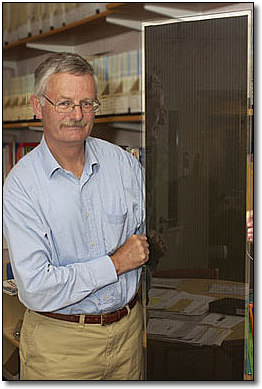
Image: University of Bath, UK
 |
Professor
Laurence Peter, head of the Department of Chemistry at the University of
Bath and leader of the solar cell research group Image: University of Bath, UK |
"As existing supplies of oil and gas dwindle, so we need to find
alternatives that will not damage the environment and solar energy is ideal for
this, even in countries like Britain where the sun doesn't always shine."
- Professor Laurence Peter, University of Bath
Bath, United Kingdom - April 30, 2004 [SolarAccess.com]
While the Bush Administration in the U.S. continues to push for an energy bill
with only piecemeal, half-hearted attempts to foster solar energy, the UK
continues to make large strides towards promoting and implementing solar
electric systems as part of the country's commitments to a national standard for
renewable energy.In the latest example of UK support, the largest single
research project into solar power ever funded by the UK research councils was
launched this month and could help make the energy source more competitive in
Britain.
The University of Bath is among six universities and seven companies in the UK
that began the £4.5 million (US$7.8 million) project this month to half the
cost of converting the sun's rays to electricity using solar cells.
"The solar energy project will make an enormously important contribution to
providing more environmentally-friendly power for the UK and the rest of the
world," said Professor Laurence Peter, (pictured above) head of the
Department of Chemistry at the University of Bath and leader of the solar cell
research group. "As existing supplies of oil and gas dwindle, so we need to
find alternatives that will not damage the environment and solar energy is ideal
for this, even in countries like Britain where the sun doesn't always
shine."
The four-year research project could make solar power a viable alternative to
fossil fuels, supplies of which are expected dwindle in the future. Cutting the
cost of solar energy will stimulate more use of it in Britain, for instance to
supply electricity in buildings by putting solar panels on their roofs.
Up to now most solar cells have traditionally been made using single crystal
silicon, which is produced in an expensive high temperature process. But the new
project will develop thin film (amorphous) solar cells, which, although less
efficient as the existing single crystal cells, are potentially much cheaper to
make.
New electroplating methods will allow cells to be put onto large area panels by
immersing them in liquid rather than by using more expensive and less
environmentally-friendly methods.
The project is funded by the Engineering and Physical Sciences Research Council
and is entitled Photovoltaic Material for the 21st Century. It is the largest
grant the EPSRC has made for solar energy research.
The other universities are: Durham, Wales, Northumbria, Southampton and
Loughborough. The companies are: Crystalox, Mats UK, Millbrook Instruments,
Epichem, Kurt J Lesker, Oxford Lasers and Gatan UK.
The project is part of the EPSRC's "Supergen" initiative, a £25
million (US$44.3 million) project to look at alternative energy sources such as
the sea, wind and the sun, and also at more efficient ways of storing power.
Copyright © 1999 - 2004 - SolarAccess.com